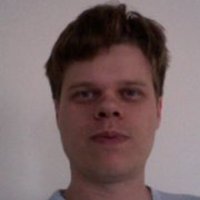Rodrigo Schramm
Universidade Federal do Rio Grande do Sul, Arts, Faculty Member
ABSTRACT This paper explores a simple yet effective way to generate temporally coherent disparity maps from binocular video sequences based on kinematic constraints. Given the disparity map at a certain frame, the proposed approach... more
ABSTRACT This paper explores a simple yet effective way to generate temporally coherent disparity maps from binocular video sequences based on kinematic constraints. Given the disparity map at a certain frame, the proposed approach computes the set of possible disparity values for each pixel in the subsequent frame, assuming a maximum displacement constraint (in world coordinates) allowed for each object. These disparity sets are then used to guide the stereo matching procedure in the subsequent frame, generating a temporally coherent disparity map. Experimental results indicate that the proposed approach produces temporally coherent disparity maps comparable to or better than competitive methods.
Research Interests:
Research Interests:
An important problem in image processing is edge detection. Such problem is particularly difficult for noisy imagens containing low contrast ed-ges, because noise typically introduces false edges. In this paper, a new pre-processing... more
An important problem in image processing is edge detection. Such problem is particularly difficult for noisy imagens containing low contrast ed-ges, because noise typically introduces false edges. In this paper, a new pre-processing technique for simultaneous image denoising and edge enhancement base on wavelets is proposed. Some experimental results indicate that the pro-posed method improves the performance of existing edge detection techniques.
Research Interests:
Research Interests: Tracking and Conductors
ABSTRACT Computerized systems for e-learning and entertainment have been created in different areas of knowledge. This work presents a system designed to track and evaluate hand movements for conducting mu-sical measures -binary, ternary... more
ABSTRACT Computerized systems for e-learning and entertainment have been created in different areas of knowledge. This work presents a system designed to track and evaluate hand movements for conducting mu-sical measures -binary, ternary and quaternary metrics -identifying for the user the maintenance of tempo and the correctness of hand patterns. The main goal of this work is to aid the study of musical rhythm for beginners, not focusing on conducting styles. The system was developed with computer vision algorithms to detect movements of the hand, and a finite-state machine was used to recog-nize the patterns. Feedback for the user is given through visual information on the screen. The accuracy of the results is verified by an external observer (a conducting specialist), with satisfactory results.
